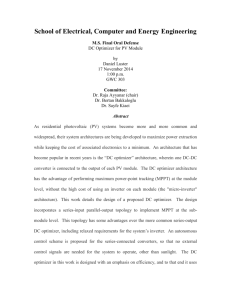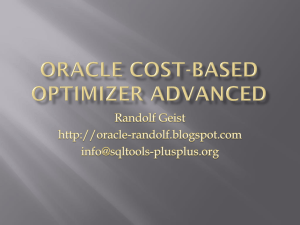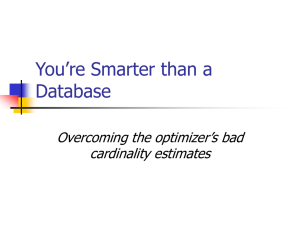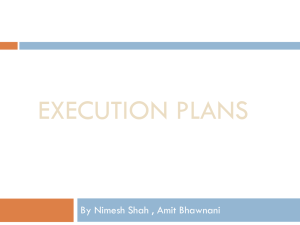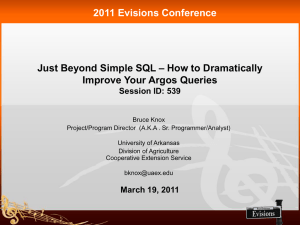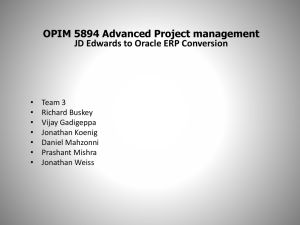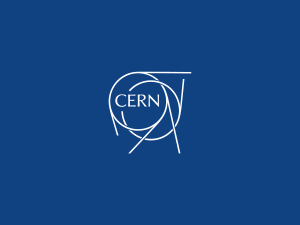Presentation slides – PowerPoint version
advertisement
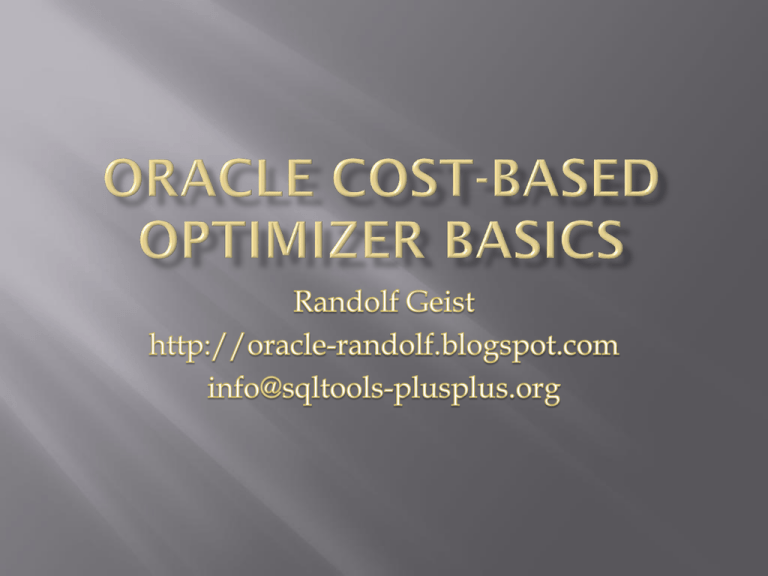
Independent consultant Available for consulting In-house workshops Cost-Based Optimizer Performance By Design Performance Troubleshooting Oracle ACE Director Member of OakTable Network Optimizer Basics – Key Concepts Proactive: Performance by design Reactive: Troubleshooting Three main questions you should ask when looking for an efficient execution plan: How much data? How many rows / volume? How scattered / clustered is the data? Caching? => Know your data! Why are these questions so important? Two main strategies: One “Big Job” => How much data, volume? Few/many “Small Jobs” => How many times / rows? => Effort per iteration? Clustering / Caching Optimizer’s cost estimate is based on: How much data? How many rows / volume? (partially) (Caching?) Not at all Single table cardinality Join cardinality Filter subquery / Aggregation cardinality Selectivity of predicates applying to a single table Selectivity of predicates applying to a single table Selectivity of predicates applying to a single table Selectivity of predicates applying to a single table Base Cardinality Filtered Cardinality / Filter Ratio Optimizer challenges Skewed column value distribution Gaps / clustered values Correlated column values Complex predicates and expressions Bind variables Demo! optimizer_basics_single_table_cardinality_testcase.sql Impact limited to a “single table” Influences the favored (Full Table Scan, Index Access etc.) Influences the and (NESTED LOOP, HASH, MERGE) => An incorrect single table cardinality potentially screws up whole ! Oracle joins exactly row sources at a time If more than two row sources need to be joined, join operations are required Many different possible (factorial!) Tree shape of execution plan Challenges Getting the right! A join can mean anything between product and a Getting the right 1,000,000 rows T1, T2 0 rows 1,000 rows T1 T2 1,000 rows Getting the right Join cardinality = Cardinality T1 * Cardinality T2 * Join selectivity T1, T2 T1 T2 Challenges Semi Joins (EXISTS (), = ANY()) Anti Joins (NOT EXISTS (), <> ALL()) Non-Equi Joins (Range, Unequal etc.) Even for the most common form of a join - the – there are several challenges Non-uniform join column value distribution Partially overlapping join columns Correlated column values Expressions Complex join expressions (multiple AND, OR) Demo! optimizer_basics_join_cardinality_testcase.sql Influences the and (NESTED LOOP, HASH, MERGE) => An incorrect join cardinality/selectivity potentially screws up whole ! Data is organized in blocks Many rows can fit into a single block According to a specific data can be either across many different blocks or in the same or few blocks Does make a tremendous difference in terms of efficiency of a “Small Job” 1,000 rows => visit 1,000 table blocks: 1,000 * 5ms = 5 s 1,000 rows => visit 10 table blocks: 10 * 5ms = 50 ms Scattered data means potentially many more blocks to compete for the Buffer Cache for the same number of rows => Caching! Scattered data can result in increased physical write (Log Writer, DB Writer) Most OLTP data has a clustering Data arriving is usually clustered together in a heap organized table Depends on the organization for example can influence this clustering even for heap organized tables Clustering of data can be influenced by implementation Physical design matters Segment space management (MSSM / ASSM) Partitioning Index/Hash Cluster Index Organized Tables (IOT) Index design / multi-column composite indexes There is a reason why the Oracle internal data dictionary uses all over the place No table access => only index blocks are visited! There is only a single measure of clustering in Oracle: The The index clustering factor is represented by a value The logic measuring the clustering factor by default does cater for data clustered across blocks (ASSM!) Challenges Getting the right There are various reasons why the index clustering factor measured by Oracle might not be Multiple freelists / freelist groups (MSSM) ASSM Partitioning SHRINK SPACE effects Re-visiting the same recent table blocks Challenges There is no clustering measurement The optimizer therefore doesn’t really have a clue about the You may need to influence the optimizer’s decisions if you know about this clustering Demo! optimizer_basics_inter_table_clustering_testcase.sql The optimizer’s model by default doesn’t consider caching of data Every I/O is assumed to be But there is a huge difference between (measured in microseconds) and (measured in milliseconds) You might have knowledge of particular application data that is and usually stays in the Buffer Cache Therefore certain queries against this “hot” data can be based on that The optimizer doesn’t know about this. You may need to the optimizer’s decisions Oracle obviously played with the idea of introducing an caching component into the cost calculation in 9i and 10g You can see this from the undocumented parameters and as well as the columns and in the data dictionary It is important to point out that even is not “free” So even by putting all objects entirely in the Buffer Cache execution plans may still lead to poor performance logical I/O, in particular on “hot blocks”, can lead to and the preferred and or determine whether strategy should be If the optimizer gets these estimates right, the resulting will be within the of the given access paths How to apply these concepts, where to go from here? Read Jonathan Lewis’ article “Designing Efficient SQL” at Red Gate’s “Simple Talk” Probably the best coverage of the concepts outlined here including clustering and caching http://www.simple-talk.com/sql/performance/designing-efficient-sql-a-visual-approach/ How to apply these concepts, where to go from here? Read one of Tom Kyte’s books to learn more about the pro’s and con’s of clusters and index organized tables How to apply these concepts, where to go from here? Learn how to read, interpret and understand Oracle execution plans => Chapter 6 of “Troubleshooting Oracle Performance” by Christian Antognini This knowledge is required in order to compare your understanding of the query to the optimizer’s understanding How to apply these concepts, where to go from here? Be aware of Query Transformations: The optimizer might rewrite your query to something that is semantically equivalent but potentially more efficient This might take you by surprise when trying to understand the execution plan favored by the optimizer Query transformation examples by courtesy of Joze Senegacnik (OOW 2010) If you want a more formal approach Read “SQL Tuning” by Dan Tow Teaches a formal approach how to design and visualize an execution plan Focuses on “robust” execution plans in an OLTP environment The formal approach doesn’t take into account clustering and caching, however it is mentioned in the book at some places If you want a more formal approach Read “Relational Database Index Design and the Optimizers” by Tapio Lahdenmäki and Michael Leach Focuses on index design Provides simple and more advanced formulas allowing to predict the efficiency of queries and indexes Covers clustering and caching For application developers Read “Use the Index, Luke” by Markus Winand Focuses on index design Provides a lot of examples how to http://use-the-index-luke.com/ design efficient database access using different front-end languages (Java, Perl, PHP, etc.) Also available as free eBook Cross database (Oracle DB2, MySQL…) If you want dive into the details of the CostBased Optimizer Read “Cost-Based Oracle: Fundamentals” by Jonathan Lewis Almost six years old Still the best book about the Oracle optimizer Covers the key concepts mentioned here in great detail Q&A
